Holi: The History of a Rich and Colorful Holiday
With its vibrant colors, mouth-watering delicacies, and booming music, Holi is one of the most popular festivals in South Asian culture.
People young and old gather around to celebrate, invigorated by the spirit of the festival. Shivas Khera ’22 described the holiday as “one of the most well-known and cherished Hindu festivals around the world.”
The rich bass of dhols fills the air as masses of people converge to participate in what is known as the most colorful holiday of the year. The smell of fresh sweets like gulab jamuns and cooling drinks like lassi are ever so tempting as the color wars begin. Vibrant reds, blues, pinks, yellows, and greens paint the faces of those who run past trying to escape the onslaught or those who race to attack their friends and family. The scene is a classic, one of numerous celebrations that surround the holiday of Holi.
Originating in India sometime in the 4th century C.E., Holi is one of the most widely celebrated festivals worldwide by South Asians. Falling on the last full moon day of the Hindu lunisolar calendar month marking the spring, it is celebrated typically in March of the Gregorian calendar and varies annually. This year, Holi was celebrated from Thursday, March 17th to Friday, March 18th, 2022.
A rich and fascinating history surrounds the festival with many details and variations depending on the region. Hindu mythology tells the story of the god Krishna, known for his mischievous nature. It is believed that when Krishna was a child, he often complained to his mother about his complexion, which was darker than that of all the other children, especially his dearest friend Radha’s. One day, his mother playfully suggested to him that if he smeared color on Radha’s face, her face would then become any color that he wanted. Fascinated by the idea, Krishna smeared Radha’s face with colors and thus, introduced the colorful festival of Holi.
Kamya Parikh ’24 recalled, “I remember hearing a lot of myths about Holi in my childhood. One of them was that the Hindu god Krishna played Holi with the village gopis [maidens].”
In Northern India, on the other hand, the holiday is centered around the myth of Prahlad and his defeat of the evil sorceress Holika. According to the myth, one day, Hiranyakashipu, the king of demons, received a boon of immortality from the god Brahma. As his influence and power grew because of the boon, so did his arrogance. He demanded that all in his kingdom should worship him instead. He was able to oppress all but one in his tyrannical rule: his son Prahlad, a devout believer in the god Vishnu. Despite numerous attempts to dissuade the young boy, Prahlad remained dedicated to his beloved god.

When all else failed, the king decided to order his sister, Holika, a well-versed sorceress in the dark magic, to sit in a pyre with the young Prahlad to eliminate him once and for all. Prahlad followed his father’s orders and sat in the pyre alongside his aunt whilst praying to Vishnu to save him. At the last moment, Vishnu intervened, and Prahlad was saved without a single ember from the fire singeing him, while Holika burned to her death.
From that day on, the triumph of good over evil was commemorated with the celebration of Holi.
In India, the celebrations last two days with the first day being dedicated to the mythological origins of the holiday and the second to celebrating. On the first day of Holi, known as Holika Dahan, people light pyres in remembrance of the pyre Holika burned on and pray to gods for good luck and prosperity for the coming spring. Offerings such as coconuts, sweets, and harvest stalks are offered into the pyre as people gather to pay their gratitude.
The real festivities, however, begin on the second day of Holi, known as Rangwali Holi. It is on this day that Holi’s famous color wars occur. Clad in white to best offset the vibrant colors, people of all ages take to the streets to participate. The festival’s charm is inescapable, overcoming generational barriers in a playful heartbeat.
Karishma Ramkarran ’23 said, “My favorite part [about Holi] is seeing my older relatives participating. Seeing my dad throw powder at me like a little kid is funny, and I really enjoy it.”
Full-scale color wars between friends, families, and even entire neighborhoods occur with some districts taking them so far as to create Holi competitions with real cash prizes. The spirit of Holi captures the hearts of all in the country of its origins.
However, there is an economic side to the holiday as well. Massive amounts of color are manufactured specifically for this day.
As Business Insider reported, “One factory in India, Radha Kishan Color World, produces 2,000 tons of color annually…churning out more than 600 pounds of the powder a day.” The industry surrounding the production of these colors is immense. Workers toil day and night in the weeks leading up to the festival to generate enough color for the public to enjoy.

Unfortunately, when such large profits are generated from sales, a counterfeit color market arises. Traditionally, Holi colors were made from natural sources, including berries, flowers, spices, and other plants. However, as the holiday became more commercialized, so did its colors.
Chemical & Engineering News reported, “with more sophisticated synthetic chemistry, the colors became brighter [than their traditional counterparts] — and in many cases more toxic…Some powders may contain toxic, metal-based pigments, such as copper sulfate, mercury sulfide, chromium iodide, lead oxide, and aluminum bromide.”
Additionally, a study by Reuters found that workers can develop punctate keratopathy, an inflammation of the cornea, and epithelial defect, a form of eye irritation caused by a scratch, foreign bodies, or chemical exposure, from exposure to these chemicals.
Nonetheless, many celebrators are not letting this ruin their beloved holiday. While awareness about toxic colors spread, so has demand for safe colors — including a return to plant-based Holi colors. Visakhapatnam-based GreenWaves Environmental Solutions, for instance, collects floral waste from temples to make their organic Holi colors, with the help of a small team of women. Online recipes have also emerged, offering a plethora of methods for making your own plant-based preparations.
The festival is not just limited to India, however; celebrations are featured worldwide. In Trinidad and Tobago, for instance, Hindus fuse their cultural heritage with the Caribbean influence of carnival in a celebration featuring a special type of folk song called ‘Chowtal.’ The song is sung throughout the festival and accompanied by the ‘dholak’ drum and ‘manjeera’ cymbals.
In Australia, the occasion is made special with a run that takes place on the Gold Coast, with a massive watercolor fight following the race. With such a massive Indian population, Australia is one of many countries where the festival of colors is just as spiritedly celebrated as at home.

In the U.S., Holi is celebrated in a variety of ways. Many attend the various Holi celebrations that occur throughout the country.
Ramkarran noted, “Usually there is a festival in Richmond Hill that my parents take me to. Across generations, Holi is a way in which we channel our culture in America.” Others prefer more family-oriented celebrations, attending gatherings with family and friends. As Shivas Khera ’22 said, “I celebrate Holi by eating special foods, throwing colors on friends and family, and going to the temple.”
Anyone and everyone is welcome to join in on the festivities. As Maheen Alam ’25 noted, “While I don’t celebrate Holi, [I’ve] been invited once to a Holi celebration. There was a lot of artwork, food, and celebrations, and it was a great experience to see other practices and celebrations of other religions.”
Ultimately, the true heart of Holi does not rely on elaborate celebrations or festivities. It is the emotions that the festival invokes in people that makes it so special.
Parikh concluded, “I love it [Holi] because the sight of everyone coming together just gives me so much joy and happiness. The colors show the brightness of our culture and our people. The festival is a way for us to let go and be free for a while and enjoy ourselves, celebrating who we are.”
Ultimately, the true heart of Holi does not rely on elaborate celebrations or festivities. It is the emotions that the festival invokes in people that makes it so special.
Pritika Patel is an Editor-in-Chief for ‘The Science Survey.’ She believes that journalism serves as the vital connection between people and the world...











